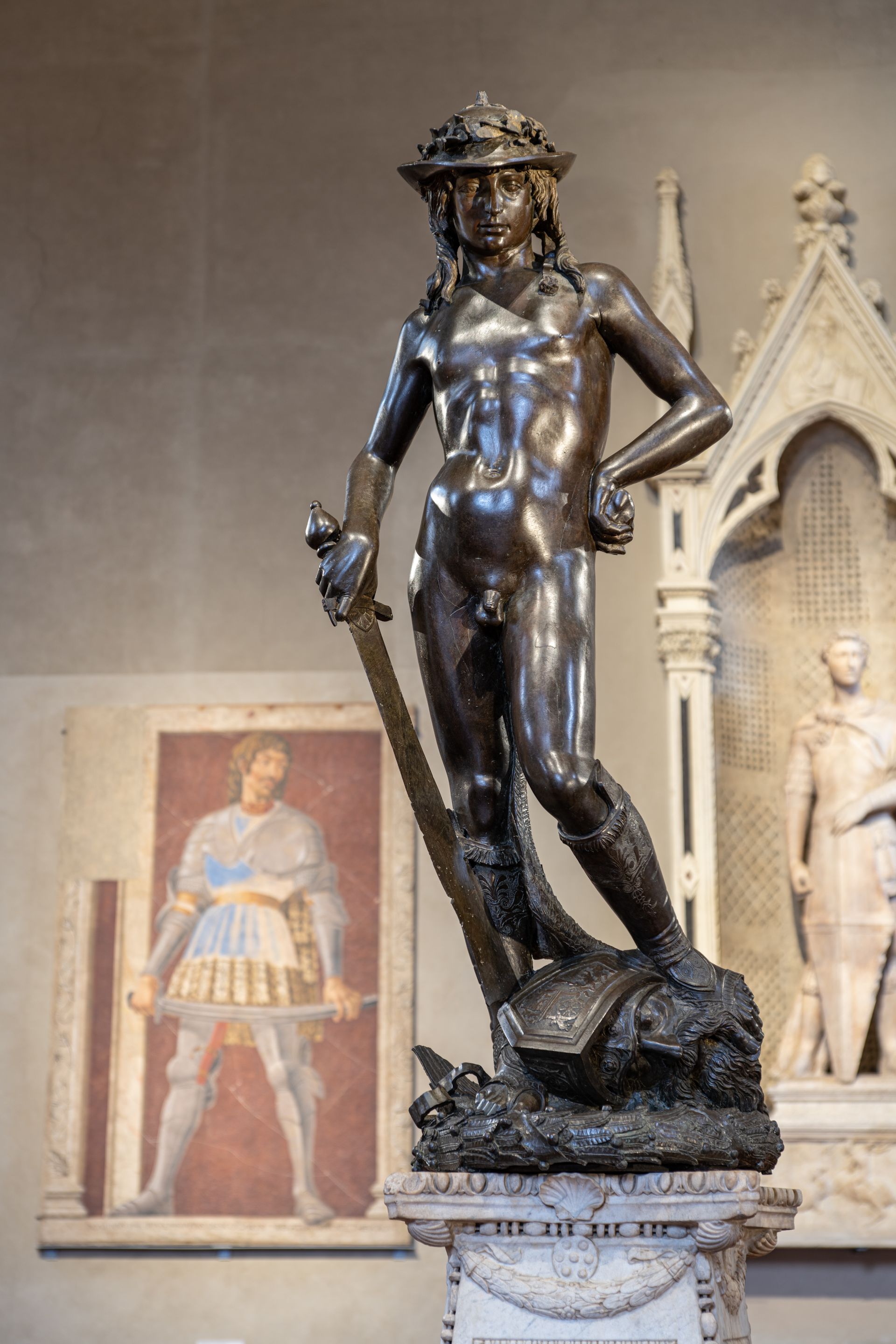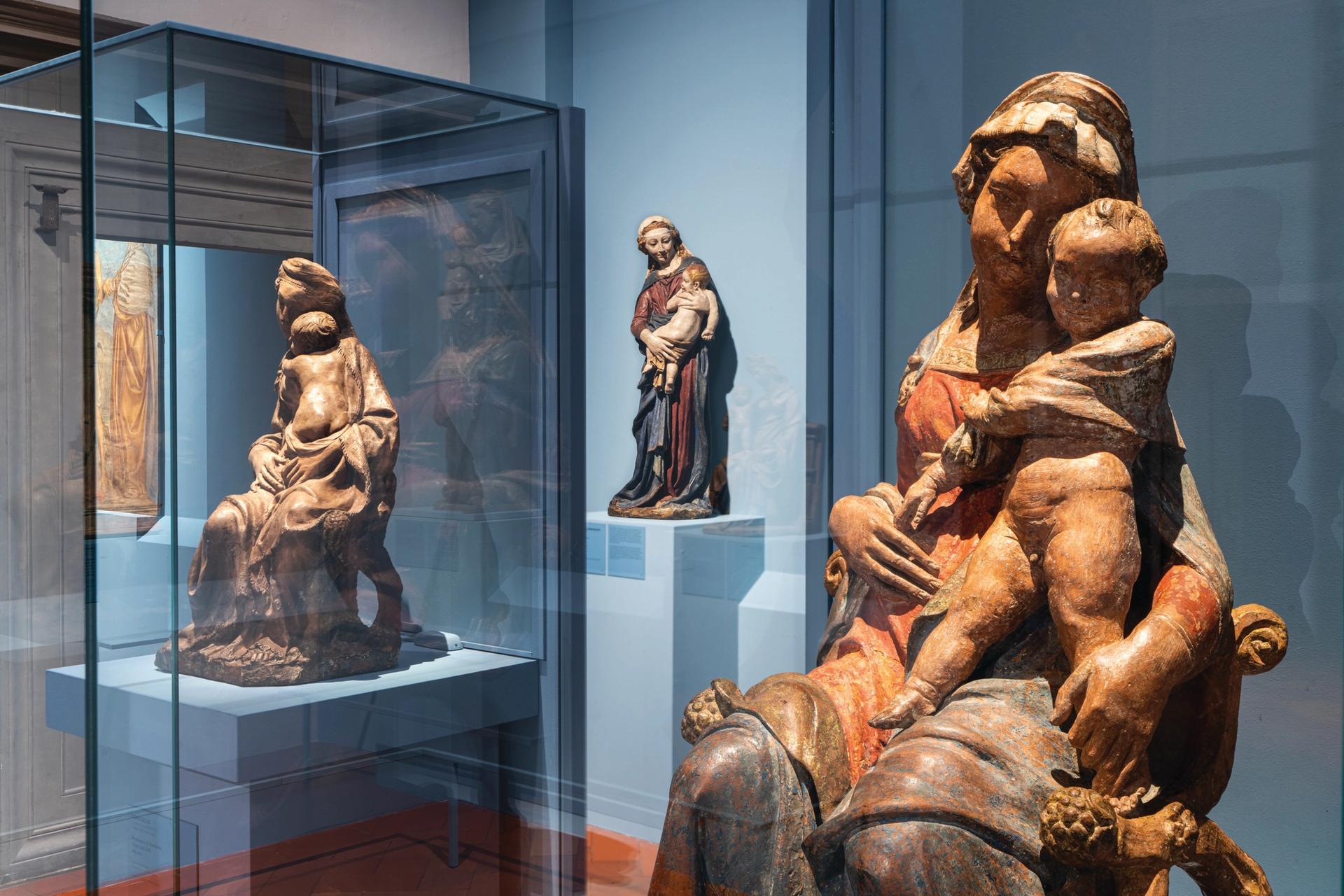Donatello the revolutionary—this is the simple idea behind this genuinely once-in-a-lifetime exhibition of Donatello’s works at Florence’s Fondazione Palazzo Strozzi and Musei del Bargello. Not just Donatello the Renaissance pioneer (1386-1466)—but Donatello the artist who was so remarkably advanced and self-assured, and who produced such a large corpus of work that it took the giants of the High Renaissance, notably Michelangelo, to begin to grasp the extent of his artistic legacy. And some of his inventions and preoccupations, the curator Francesco Caglioti says, were only finally assimilated in our age of photography and cinema.
Smaller iterations of the show will travel to Berlin and London but the Florence exhibition is the only place to experience Donatello’s work in all its many manifestations—terracotta, bronze, gold, wood and marble to name just some of his materials—and its diversity of scale (from intimate reliefs to monumental bronze doors), while also providing the added bonus of being able to visit the original locations (such as the church of Santa Croce) where some of Donatello’s devotional works would likely have stopped Quattrocento worshippers in their tracks.
Spread over the two venues, the exhibition comprises 130 works, organised thematically and chronologically, which not only reflect the different centres where Donatello worked (including Florence, Siena, Padua and Prato) but also the reception of his works by contemporaries such as Masaccio, Mantegna and Bellini, through to his profound impact on later artists like Michelangelo, Raphael and Bronzino. The only small disappointment is that Donatello’s works mostly outshine the comparative examples of paintings by artists of his own time, revealing not only their limitations but also—illuminatingly—the limitations of painting itself.

Donatello's David Victorious (1408-09; adapted in 1416), at Musei del Bargello, Florence. Courtesy of Musei del Bargello.
The Strozzi show opens with the monumental marble statue of David Victorious (1408-09; adapted in 1416), executed when Donatello was in his 20s. Still late Gothic in its elegance, it nevertheless boasts an arrogance and assertiveness that is new. At the Bargello, we see how Donatello builds on this to create the mature style, so beloved by Florence’s Medici rulers, in his most famous work—again of David Victorious, but this time in bronze (around 1435-40). This later David is sensuously antique rather than Gothic, designed to be seen almost erotically in the round (it originally stood atop a column), hand on hip, feathered wing caressing his inner thigh, and with a face of great classical beauty comparable with the antique busts of the Greek youth Antinous.
During the first decade of the 15th century, Donatello and Brunelleschi, the great architect (notably of Florence Cathedral’s dome), sculptor, designer and engineer, formed a close partnership, inspired by their shared admiration for the artistic feats of Ancient Greece and Rome. They also egged each other on, as the Strozzi display demonstrates via a juxtaposition of the two artists’ celebrated painted wooden crucifixes, with Donatello announcing forcefully that he is going to do things differently. His crucifix of around 1408, which, as Vasari tells us in his Lives of the Artists, Donatello took “extraordinary pains” over, was derided by Brunelleschi, who felt he had “put a peasant on the cross”. Here, we see Donatello presenting Christ as the son of a carpenter in a way that presages Caravaggio’s radical naturalism.

A room dedicated to Donatello's terracottas of the Virgin and Child.
Caglioti’s excitement at presenting Donatello’s transgressive spirit and extraordinary achievement in all its delicate and dramatic cadences is palpable throughout the exhibition, from the master’s invention of non finito (the “unfinished”) to sprezzatura (a studied nonchalance and effortlessness). It comes to the fore early on in a room devoted to Donatello’s 1410-20 terracottas of the Virgin and Child, which includes some fresh attributions. So how did Donatello disrupt the norm here? The answer lies in the way he introduces the spectator’s presence into the psychological interplay between the figures. Thus, the Christ child interacts with us playfully or with an infant’s self-conscious awareness—feigning fear but also betraying natural curiosity. One always feels Donatello’s delight in such ambiguities, while also sensing the restlessness of his invention in the impressionistic handling of the clay.
And he never stands still. In the glorious marble relief of the Pazzi Madonna (around 1422, from the Staatliche Museen in Berlin), the Madonna and Child are now presented in such an intense and tender relationship that—for the first time in art history, Caglioti suggests—they don’t give a damn about the spectator: a Renaissance public would have been accustomed to feeling “seen” by the Virgin as, in answer to their prayers, she interceded on their behalf. Now, Madonna and child are locked together in the intensity of their own gaze, embrace and conjoined destinies. Again, there is ambiguity. The child clutches his mother, whose strong, “Greek” profile radiates melancholic foreboding, while also seeming to gently push her away—anticipating their final separation.
The Pazzi Madonna is one example in a room at the Palazzo Strozzi devoted thematically to sculpted and painted space. Brunelleschi invented one-point perspective, and Donatello must have delighted in his friend’s optical and mathematical experiments and their transfer from creating a convincing painted space to sculpted space. To embrace this momentous discovery, Donatello developed his own distinctive low-relief style known as schiacciato, in which the flattened sculptural relief has progressively thinner degrees of thickness to suggest extremely delicate shifts of plane as one journeys into “depth”, while also creating a minute play of light and shade. The Hildburgh Madonna (around 1420-30) and the Madonna of the Clouds (around 1425-30; exhibited in the Bargello) take this to increasingly sublime technical and emotional levels.

Feast of Herod (1423–27), a gilded bronze relief from the baptismal font in Siena is displayed in a public exhibition for the first time
A real highlight in terms of this exploration of the possibilities of sculpted space is the restored Feast of Herod (1423–27) gilded bronze relief from the baptismal font in Siena, displayed in a public exhibition for the first time. Brunelleschi’s perspective system ensured that everything made sense from a central viewpoint, but it meant that the spectator had to stand still. Donatello upends this, creating multiple, ambiguous, glittering spaces that can be experienced romantically and psychologically as well as spatially. We can move around freely—from the banqueting table to the music room, to the jail where St John the Baptist has been beheaded—but, like the saint, we experience a sense of confinement wherever we go.
We feel this charged atmosphere in a different manner in two other extraordinary loans—the bronze Door of the Apostles and the Door of the Martyrs (around 1440-42) from the Old Sacristy of San Lorenzo, in Florence, the latter of which has just been restored. Controversially, Donatello decides to abandon the traditional attributes of the many pairs of disputing saints and apostles (as we move from the top panels to the lower ones), so that the viewer becomes immersed in the bristling energy of theological debate and the moral cut and thrust of the arguments. This creative freedom perplexed even his greatest admirers: the sculptor Filarete compared the religious figures to fencers.
Towards the end of his long life, Donatello confined himself to bronze: he did not carry on into old age, like Michelangelo, battling with the physical demands of sculpting in stone. He now worked almost exclusively for the Medici. Shortly after his death, Michelangelo, who himself was to become a Medici favourite, seized the baton. At just 15 years of age, he created his marble bas relief the Madonna of the Stairs (around 1490), which has been borrowed from the Casa Buonarotti for the show’s final room, in the Bargello. Seen in the company of Donatello’s Dudley Madonna (around 1440), it is revelatory. Michelangelo has absorbed Donatello’s spirit—here, the Christ child even turns his back on us as he struggles to feed, his arm dangling down as it will later in death—while his “Greek” Donatellesque Madonna stares into the turbulent future.
• Donatello: The Renaissance, Palazzo Strozzi and Museo Nazionale del Bargello, Florence, 19 March—31 July. Curator: Francesco Caglioti


